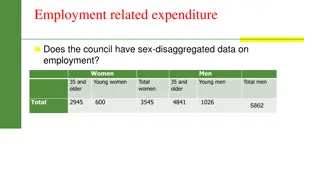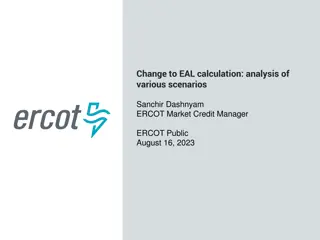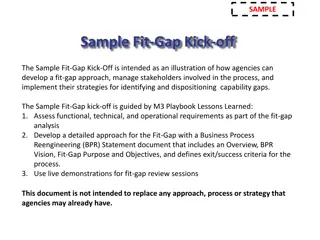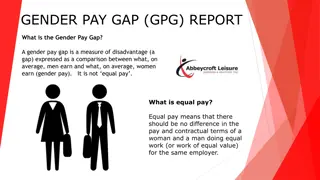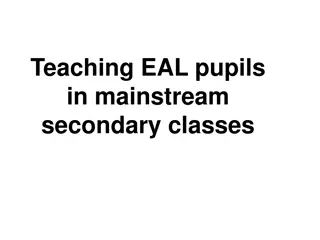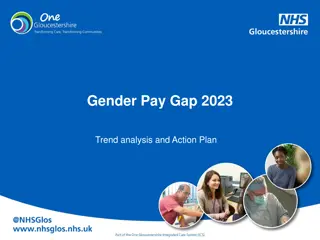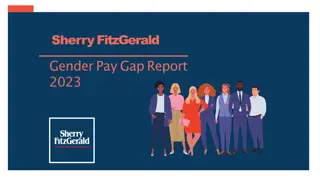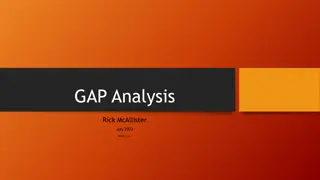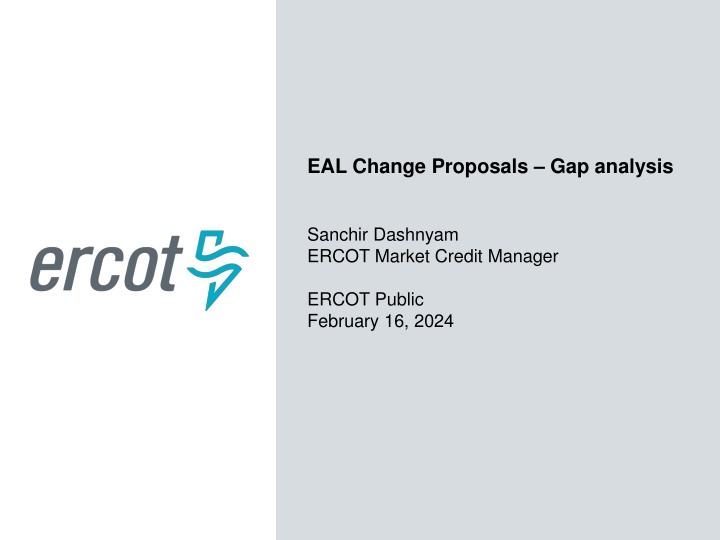
EAL Change Proposals Gap Analysis for ERCOT Market Credit Manager
Explore the EAL change proposals gap analysis presented by Sanchir Dashnyam, ERCOT Market Credit Manager, focusing on invoice exposures, definitions, current EAL formulas, and scenarios. Understand TPEA variations across different scenarios and gain insights into market, load, and generation dynamics.
Download Presentation

Please find below an Image/Link to download the presentation.
The content on the website is provided AS IS for your information and personal use only. It may not be sold, licensed, or shared on other websites without obtaining consent from the author. If you encounter any issues during the download, it is possible that the publisher has removed the file from their server.
You are allowed to download the files provided on this website for personal or commercial use, subject to the condition that they are used lawfully. All files are the property of their respective owners.
The content on the website is provided AS IS for your information and personal use only. It may not be sold, licensed, or shared on other websites without obtaining consent from the author.
E N D
Presentation Transcript
EAL Change Proposals Gap analysis Sanchir Dashnyam ERCOT Market Credit Manager ERCOT Public February 16, 2024
Invoice Exposures Definitions Invoice exposures New M1 days forward invoices + 7 days look back actual invoices M1 days could range from 10 to 21 days depending on weekends/holidays, MP activity Invoices exclude M&N securitization invoices, CRR auction invoices and miscellaneous invoices relating to $2B distributed to market for Sec N on 6/21/22 Data is for a period covering 1/1/2022 through 11/30/23 TPEA excludes Uri invoices and PUL uplift TPEA Invoice exposures = Gap Negative gap is when invoice exposures exceed TPEA (less than -$10,000) Positive gap is when TPEA exceeds invoice exposures (more than $10,000) 2 ERCOT Public
Current EAL Formula vs. Scenarios #1, #2 and #3 Current: EAL q = Max [IEL during the first 40-day period only beginning on the date that the Counter-Party commences activity in ERCOT markets, RFAF * Max {RTLE during the previous lrq days}, RTLF] + DFAF * DALE + Max [RTLCNS, Max {URTA during the previous lrq days}] + OUT q + ILEq Scenario #1: EAL t = Max [RFAF * Max { RTNLE during the previous lrt days}, FAF*RTNLF] + DFAF * DALE + Max [RTLCNS NLCD, Max {ULERTA during the previous lrq days}] + OUTt Use same RTM ODs for DAM as well NLF = net liability forward = 1.5 * NLCD NLCD = (7 most recent Operating days Real time estimates + 7 most recent DAM ODs day-ahead) if settled data is available use settled else estimates no price cap FAF = 21 future / most recent days 7 RTM Prices ULE = unbilled liability extrapolated (Last 14 days RTM Initial Statement Average + Last 14 days DAM Initial Statement Average based on RTM Initial OD)*M2 - use same RTM ODs for DAM as well NLE = Total net liability extrapolated (Last 14 days RTM Initial Statement Average + Last 14 days DAM Initial Statement Average based on RTM Initial OD)*M1. Scenario #2: EAL q = Max [IEL during the first 40-day period only beginning on the date that the Counter- Party commences activity in ERCOT markets, Max{(RFAF * Max {RTLE) during the previous lrq days}, RTLF] + DFAF * DALE + Max [RTLCNS, Max {URTA during the previous lrq days}] + OUT q + ILE q Scenario #3: EAL q = Max [IEL during the first 40-day period only beginning on the date that the Counter- Party commences activity in ERCOT markets, RFAF * Max {RTLE during the previous lrq days}, RTLF] + DFAF * DALE + Max [RTLCNS, Max {URTA during the previous lrq days}] + OUT q + ILE q Two RFAF s: CP specific RFAF and Global RFAF CP specific RFAF = Projected Real-Time ICE Forward Average Price / Max RTLE date Historic Real-Time Settled Average Price Global RFAF is calculated based on existing methodology. Global RFAF is used in MCE calculations. 3 ERCOT Public
TPEA for Scenario#1,#2,#3 vs Current: Market, Load & Gen, Load 4 ERCOT Public
Negative and Positive Gaps: Market Market Negative Gap Current S1 S2 S3 Sum total (23,143,724,846) $ (16,956,471,303) $ (20,493,890,939) $ (27,153,592,045) $ Compared to Current # of occurences Compared to Current -26.7% -11.4% 17.3% Average (1,855,208) $ (1,809,462) $ (1,704,557) $ (2,062,716) $ Compared to Current 12,475 9,371 12,023 13,164 -24.9% -3.6% 5.5% -2.5% -8.1% 11.2% Positive Gap Current S1 S2 S3 Sum total 756,001,544,967 $ 861,304,300,397 $ 727,095,493,425 $ 609,245,103,532 $ Compared to Current # of occurences Compared to Current 217,072 13.9% 220,149 -3.8% 217,480 -19.4% 215,952 Average 3,482,723 $ 3,912,370 $ 3,343,275 $ 2,821,206 $ Compared to Current 1.4% 0.2% -0.5% 12.3% -4.0% -19.0% Current 97,845,847 $ S1 S2 S3 Cost Change (%) Change ($) 113,118,702 $ 94,249,170 $ 77,192,980 $ 16% -4% -21% 15,272,855 $ (3,596,677) $ (20,652,867) $ Negative gaps Scenario #1 lowers negative gaps the most while Scenario #3 increases negative gaps Scenario #1 reduces negative gap occurrences by 25%, aggregate total negative gap amounts by 27% with the average negative gap amounts decreasing 2.5%. Scenario #2 reduces negative gap occurrences by 4%, aggregate total negative gap amounts by 11% with the average negative gap amounts decreasing 8%. Scenario #3 increases negative gap occurrences by 5.5%, aggregate total negative gap amounts by 17% with the average negative gap amount increasing by 11%. Positive gaps Scenario #3 will lower positive gaps the most while Scenario #1 will increase them Scenario #1 increases positive gap occurrences by 1.4%, increases aggregate total positive gap amounts by 14% with the average positive gap amount increasing 12.3%. Scenario #2 yields about the same positive gap occurrences as current, while decreases aggregate total positive gap amounts by 3.8% with the average positive gap amount decreasing by 4%. Scenario #3 reduces positive gap occurrences by 0.5%, aggregate total positive gap amounts by 19% with the average positive gap amount decreasing 19%. Scenario #1 increases cost to the market by 15% while Scenario #3 lowers the cost by 21% and Scenario #2 by 4%. Cost is estimated at 5% per annum, 365 days and is calculated on TPEA for each scenario. 5 ERCOT Public
Negative and Positive Gaps: Load & Gen, Load Load and Gen Negative Gap Current S1 S2 S3 Sum total (16,575,952,246) $ (13,337,366,370) $ (14,312,625,229) $ (20,235,043,136) $ Compared to Current # of occurences Compared to Current -19.5% -13.7% 22.1% Average (4,974,776) $ (6,339,052) $ (4,714,303) $ 107,734,439 $ Compared to Current 3,332 2,104 3,036 3,627 -36.9% -8.9% 8.9% 27.4% -5.2% -2265.6% Positive Gap Current S1 S2 S3 Sum total 503,851,291,969 $ 571,912,859,983 $ 488,075,952,770 $ 390,752,810,513 $ Compared to Current # of occurences Compared to Current 13.5% -3.1% -22.4% Average 21,142,684 $ 22,878,345 $ 20,204,328 $ 16,627,072 $ Compared to Current 23,831 24,998 24,157 23,501 4.9% 1.4% -1.4% 8.2% -4.4% -21.4% Load Negative Gap Current S1 S2 S3 Sum total (4,240,615,614) $ (1,986,727,802) $ (3,974,288,505) $ (4,516,253,829) $ Compared to Current # of occurences Compared to Current -53.2% -6.3% 6.5% Average (1,139,950) $ (843,263) $ (1,085,871) $ (1,118,161) $ Compared to Current 3,720 2,356 3,660 4,039 -36.7% -1.6% 8.6% -26.0% -4.7% -1.9% Positive Gap Current S1 S2 S3 Sum total 87,391,465,184 $ 123,037,667,657 $ 77,085,191,368 $ 61,503,229,868 $ Compared to Current # of occurences Compared to Current 40.8% -11.8% -29.6% Average 3,690,674 $ 4,893,905 $ 3,259,830 $ 2,672,891 $ Compared to Current 23,679 25,141 23,647 23,010 6.2% -0.1% -2.8% 32.6% -11.7% -27.6% 6 ERCOT Public
Negative and Positive Gaps: Gen, Traders Gen Negative Gap Current S1 S2 S3 Sum total (173,886,007) $ (166,878,794) $ (138,880,942) $ (163,312,341) $ Compared to Current # of occurences Compared to Current -4.0% -20.1% -6.1% Average (552,019) $ (738,402) $ (490,745) $ (499,426) $ Compared to Current 315 226 283 327 -28.3% -10.2% 3.8% 33.8% -11.1% -9.5% Positive Gap Current S1 S2 S3 Sum total 48,520,559,983 $ 48,101,715,107 $ 46,971,435,867 $ 45,690,121,352 $ Compared to Current # of occurences Compared to Current -0.9% -3.2% -5.8% Average 2,105,744 $ 2,082,415 $ 2,038,868 $ 1,987,391 $ Compared to Current 23,042 23,099 23,038 22,990 0.2% 0.0% -0.2% -1.1% -3.2% -5.6% Trader Negative Gap Current S1 S2 S3 Sum total (2,008,174,843) $ (1,314,508,991) $ (1,922,988,390) $ (2,073,143,698) $ Compared to Current # of occurences Compared to Current -34.5% -4.2% 3.2% Average (499,546) $ (369,348) $ (485,849) $ (507,750) $ Compared to Current 4,020 3,559 3,958 4,083 -11.5% -1.5% 1.6% -26.1% -2.7% 1.6% Positive Gap Current S1 S2 S3 Sum total 108,380,223,721 $ 111,039,863,591 $ 107,052,764,273 $ 103,483,283,953 $ Compared to Current # of occurences Compared to Current 119,492 2.5% 120,012 -1.2% 119,576 -4.5% 119,421 Average 907,008 $ 925,240 $ 895,270 $ 866,542 $ Compared to Current 0.4% 0.1% -0.1% 2.0% -1.3% -4.5% 7 ERCOT Public
Market 8 ERCOT Public
Correlation: Invoice Exposures vs Current, Scenario #1-3 Both scenarios appear to have higher correlation with invoice exposures compared to the existing methodology. Scenario #3 appears to have the highest correlation with invoice exposures, though the marginal difference compared to Scenario #2 appears not that significant. Scenario #2 lowers negative gaps while Scenario #3 increases negative gaps. Scenario #3 lowers the positive gaps the most. 9 ERCOT Public
Summary: Current vs Scenario #1, Scenario #2 and Scenario #3 Conclusion Perceived overcollateralization Scenario #2 lowers positive gaps while also lowering negative gaps. Specifically, Scenario #2 appears to better solve "double top" or "2nd top" TPEA behavior without bringing excessive amount of risk. All scenarios struggle to solve the timing lag - negative gaps occurring (to a large extent) before the price spike. Coming into the high price environment, MCE is driving the TPE, both scenarios do not shorten the lag as compared to the existing TPE the results are mostly the same. When RTLE is coming off of lower base, reflecting lower prices and/or overhedged positions as the price spike event happens the short position will be captured through RTLCNS first then through RTLE, but only after the fact. S-C P99 P95 P90 P85 S1 P99 P95 P90 P85 S2 P99 P95 P90 P85 S3 P99 P95 P90 P85 Gap$ $ $ $ $ Gap$ $ $ $ $ Gap$ $ $ $ $ Gap$ $ $ $ $ Total Count Total Count Total Count Total Count 12,475 0.99% 4.99% 10.00% 15.00% 9,371 0.99% 4.99% 10.00% 14.99% 12,023 1.00% 5.00% 10.00% 15.00% 13,163 1.00% 5.00% 10.00% 15.00% 32,256,967 7,147,189 3,016,056 1,768,878 124 623 1,247 1,871 Change 34,269,039 6,809,489 2,534,009 1,367,405 93 468 937 6% -5% -16% -23% 1,405 Change 30,167,545 5,899,975 2,546,623 1,499,844 120 601 -6% -17% -16% -15% 1,202 1,803 Change 35,312,609 8,178,899 3,293,669 1,946,624 131 658 9% 14% 9% 10% 1,316 1,974 * 2022 and 2023 negative gaps < $10,000 10 ERCOT Public



